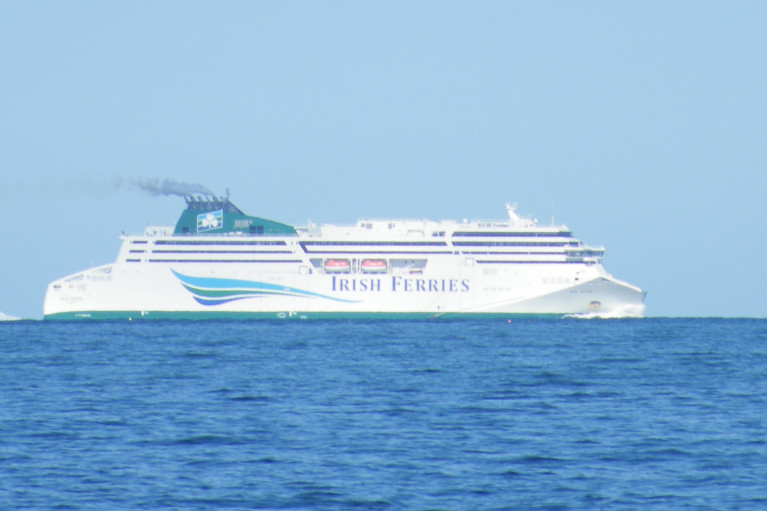Displaying items by tag: Freight Boost
Stena Line has announced that it is constructing two new bespoke freight ferries for Irish Sea service on its expanding Belfast-Heysham freight route.
The multi-million pound investment will significantly increase freight capacity on the route.
Each of the two new 147-meter vessels has been designed to maximise freight volumes and will provide 2,800 lane meters of capacity which is an 80% increase on current ship capacities.
The new vessels will be equipped to carry 12 passengers and 26 crew. The ‘NewMax’ vessels will be able to operate on methanol fuel.
Stena Line is currently working closely with the supply chain of methanol and has secured future volumes of e-methanol to fulfil its strategic ambition of shifting to renewable fuels and cutting 30% of its CO2 emissions by 2030.
Future proofing of the new vessels for electrification will also be another priority during construction providing in-built technologies that can take advantage of both battery propulsion and shore power, where this is available.
The unique tidal systems prevailing in Heysham can be challenging, so each vessel will be fitted with a bespoke marine technology configuration making it more resilient to the prevailing weather conditions. Three bow thrusters will provide optimum maneuverability and reliability and a specially designed engine/propeller configuration will further enhance berthing capability in extreme weather.
Paul Grant, Stena Line Trade Director said: “This is very significant day for Heysham-Belfast freight traffic. By adding an extra 80% capacity to the route, Stena Line has responded to growing demands from customers.
We have operated a very popular service on Heysham-Belfast for several years now but with restricted capacity it has been challenging to meet increased market growth. With the extra capacity, we will now be able to significantly enhance our service on this route and complement our Birkenhead, Cairnryan and Holyhead services.”
Phil Hall, Mersey Port Director at Peel Ports Group, said: “The Heysham-Belfast freight service is extremely important to the Port of Heysham. The construction of Stena Line’s two new ferries will go a long way towards meeting increased customer demand, while the additional capacity will allow for enhanced services for our port users. It’s a fantastic project to be supporting, and we look forward to delivering a bigger and better freight service for our customers from 2025 onwards.”
Stena Line is the largest ferry operator on the Irish Sea, with the biggest fleet offering the widest choice of routes including, combined passenger and freight services from Belfast to Cairnryan and Liverpool, Dublin to Holyhead, and Rosslare to Fishguard routes. As well as this dedicated freight only route from Belfast to Heysham, a total of up to 238 weekly sailing options between Ireland and Britain.
The ferry company also offers a direct service from Rosslare to Cherbourg and will be introducing an upgraded ship, Stena Vision, to this route for summer 2023, making this route the most frequent service from Ireland to France with 12 sailings per week.
Irish Ferries Boost Freight Capacity As W.B. Yeats Enters Service Early on Direct France Route
W.B. Yeats, the largest ferry operating out of Dublin Port has switched from the Holyhead route to Dublin-Cherbourg due to the continued surge in freight demand on direct routes to France, writes Jehan Ashmore.
The 165 freight accompanied unit capacity Irish Ferries ship began the Ireland-mainland Europe route last week though the cruise ferry was originally scheduled to enter service but not until 25 May, marking the traditonally busier summer season.
Irish Ferries early redeployment of the larger lorry-driver cabin capacity W.B Yeats on the French route led to the transfer of the chartered ropax Epsilon to return on the Dublin-Holyhead route. The smaller ropax works in tandem with the cruise ferry Ulysses though passenger demand on the Irish Sea is low given this quiet time of the year coupled with Covid-19 restrictions. While rivals, Stena Line recently implemented temporarily a reduction in sailings as Afloat reported due to supply-chain issues.
The swap of vessels between these routes is no surprise given the surge in demand experienced in Rosslare Europort where rivals Stena Line prior to the festive season stepped up capacity also to Cherbourg that was due to begin last Monday.
In addition the launch by DFDS new Rosslare route to Dunkirk on 2nd January is another indicator of such freight demand. The level in haulage capacity is to increase yet further when Brittany Ferries in March will also connect the Wexford ferryport and Cherbourg.
The Normandy port is not only proving a convenient and strategic port for Irish haulage firms and other customers using three ferry operators, as Brittany Ferries recently reintroduced the freight-only ferry Cotentin but serving the UK.
After an absence of 7 years for the French operator, Cotentin's Stena Line Baltic Sea service ceased late last year with the freighter returning to English Channel service sailing on New Year's Day on the Cherbourg-Poole route.
Cotentin is back due to the UK Department for Transport's contract for extra freight capacity on routes to France following Brexit and the consequent termination of the free trade agreement with the EU.
In April, Barfleur the route's routine ferry resumes service and will offer passenger capacity too.
























































